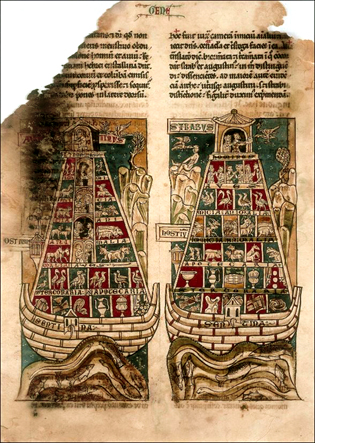University and Library's historical background
The Universidad Complutense receives its name from the primitive institution founded by Cardinal Cisneros in Alcalá de Henares, in the transition from the 15th to the 16th century. The ¨Reglamento general de instrucción pública¨ (General Regulation of Public Instruction) of 1821, during the constitutional three-year period, transferred the University to Madrid from Alcalá. The "Universidad Central" that incorporated the teachings, faculties and libraries from Alcalá was solemnly opened in the year 1822. Although Fernando VII regained his throne as the absolute monarch of Spain and the resolutions of the prior regime were repealled, the installation of the University in Madrid was definitely recognized by the ¨Real Orden de la Reina Regente" (Royal Order of the Regent Queen) on October 29, 1836. Through the ¨Plan de Instruccion Publica" (Public Instruction Plan) of Pedro Jose Pidal, on September 17, 1845, several faculties were intergrated to the University. These were the Medicine school, established in the Real Colegio de San Carlos founded by Carlos III in 1779, the Pharmacy from the Real Colegio de Farmacia established by Carlos IV in 1806 and Philosophy studies from the Reales Estudios de San Isidro de Madrid.
Rodrigo Ximénez de Rada. "Breviarium historiae catholicae". [BH MSS 138]
Provenance of the holdings:
The origin of the Biblioteca de la Universidad Complutense may be traced to the period of the foundation of its University. It started with the collection obtained by the Cardinal Cisneros. In the oldest inventory of the collection, written in 1512, some of the most determinant works that still today are preserved at the Biblioteca Histórica, such as the ¨Libros del saber de astronomia¨ of Alfonso X el Sabio ,already appear.
Other educational institutions integrated in the University also contributed with their rich scientific collections. These were the Reales Estudios de San Isidro (formerly Colegio Imperial de los Jesuitas), the Real Colegio de Medicina y Cirugía de San Carlos, the Real Colegio de Farmacia or the Real Colegio de Veterinaria.
During the 19th century the collection was remarkably enlarged by the contributions made by some prominent individuals. Bibliophiles like the Countess of Alange, the politician Juan Francisco Camacho, university professors such as Chinchilla, Hernández Morejón, Julián Sanz del Rio, Luis Simarro or Rafael Ureña, and the rectors Fernando de Castro and Rafael Luque Conde helped to create a very valuable historical collection.
Such a rich heritage needed a facility that could guarantee its conservation and appropriate utilization. On this effect, the Biblioteca Histórica was developed to provide a centralized management and storage for all these ancient collections. Adjacent to the ancient university at San Bernardo street, a building situated at the Noviciado street, constructed in 1928 and financed by Ramón Pelayo de la Torríente, the Marquis of Valdecilla, is now the present location of this priceless ancient collection.
The Biblioteca Histórica of the Complutense University of Madrid is the second in rank in Madrid regarding books dated before the 19th century, next to the Biblioteca Nacional. and, undoubtedly, Biblioteca Histórica, is one of the top five libraries in Spain. Our bibliographical collection includes 3,000 manuscripts, 741 incunabula and approximately 150,000 volumes of books printed from the 16th up to the 18th centuries. A few but notable collection of engravings and illustrated books is also preserved in the Library

